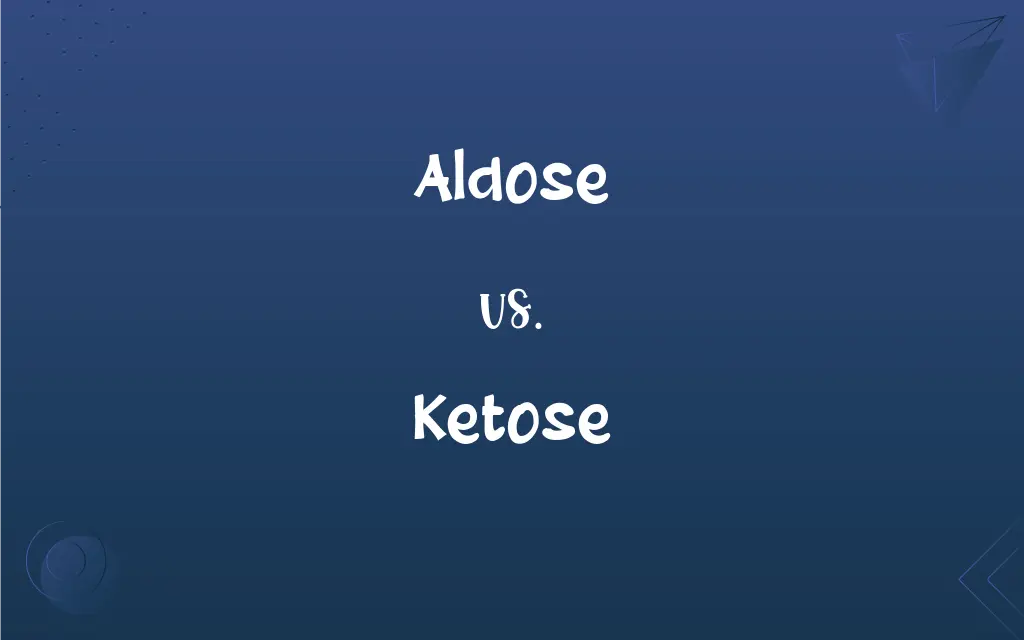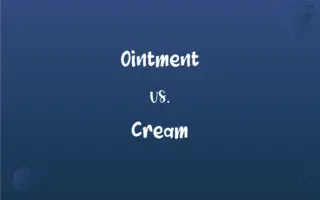Aldose vs. Ketose: What's the Difference?
Edited by Janet White || By Harlon Moss || Updated on October 5, 2023
Aldose contains an aldehyde group, while ketose contains a ketone group, both being simple sugars differing in their functional groups.

Key Differences
Aldose, from a biochemical perspective, refers to a monosaccharide (simple sugar) with an aldehyde group (-CHO) at its end. In contrast, ketose signifies another kind of monosaccharide, distinguished not by an aldehyde but by a ketone group (C=O) within its carbon chain. These fundamental molecular distinctions lead to unique properties and roles within their respective biological environments.
In the realm of aldose, glucose is a primary representative and it plays a pivotal role in providing energy in biological systems. On the opposite end, ketose, represented significantly by fructose, offers not just a different structural format, but also imparts distinctive metabolic pathways, specifically, varied processes in how organisms derive energy from these sugars.
Diving deeper into aldose and its properties, it’s critical to observe that its aldehyde group allows it to isomerize and form intramolecular hemiacetals, impacting its reactivity and role in biochemical pathways. Conversely, ketose, while also capable of isomerizing to form hemiketals, demonstrates this property through its interior ketone group, reflecting an intrinsic difference in how these two sugars interact chemically.
In the context of chemical reactivity, aldose sugars engage in certain specific reactions, such as reducing Tollens’ reagent, due to their aldehyde group. Contrariwise, ketose sugars, though not always directly reducing, can, under certain conditions (such as in alkaline medium), tautomerize to aldoses, exhibiting their own unique chemical behaviors.
Speaking to their prevalence and role in nature, aldose, and its representative glucose, is notably present in various forms, such as in the polysaccharide cellulose. Ketose, symbolized through fructose, also manifests abundantly in nature, especially in fruits, highlighting both sugars as critical contributors to the biological and chemical landscapes of organisms.
ADVERTISEMENT
Comparison Chart
Functional Group
Aldehyde (-CHO)
Ketone (C=O)
Representative Monosaccharide
Glucose
Fructose
Reactivity
Can reduce Tollens’ reagent
May tautomerize to an aldose and reduce Tollens' reagent
Formation of Cyclic Forms
Forms hemiacetals
Forms hemiketals
Common Occurrence
Found in cellulose
Common in fruits
ADVERTISEMENT
Aldose and Ketose Definitions
Aldose
A sugar with an aldehyde group.
Glucose, an essential energy source, is a typical aldose.
Ketose
A sugar containing a ketone group.
Fructose, found in many fruits, is a common ketose.
Aldose
Monosaccharides featuring a carbon double-bonded to an oxygen and single-bonded to a hydrogen.
Galactose, found in milk, is an aldose and essential for energy.
Ketose
Sugars that can also form five or six-membered rings through intramolecular reactions.
Fructose, a ketose, forms a five-membered ring when cyclized.
Aldose
Sugars that can form a six-membered ring structure through intramolecular reactions.
In aqueous solutions, the aldose glucose predominantly exists in a cyclic form.
Ketose
Monosaccharides with a carbonyl group within the carbon chain.
Ribulose, a ketose, is involved in the photosynthetic Calvin cycle.
Aldose
A carbohydrate that can reduce other compounds in reactions.
The aldose, glucose, is capable of reducing Cu^2+ to Cu^+ in solution.
Ketose
A sugar capable of tautomerizing into an aldose form under certain conditions.
Fructose, a ketose, can tautomerize into an aldose under alkaline conditions.
Aldose
A sugar that can exist in D- and L- isomeric forms.
D-Glucose, an aldose, plays a fundamental role in cellular respiration.
Ketose
A carbohydrate that also possesses D- and L- isomeric forms.
D-Fructose, a ketose, is a sweet-tasting sugar found in honey.
Aldose
Any of a class of monosaccharide sugars containing an aldehyde group.
Ketose
Any of various carbohydrates containing a ketone group.
Aldose
Any of a class of monosaccharides having an aldehyde or hemiacetal functional group.
Ketose
(carbohydrate) A saccharide containing a ketone functional group.
Aldose
A monosaccharide sugar that contains the aldehyde group or is hemiacetal
Ketose
Any monosaccharide sugar that contains a ketone group or its hemiacetal
FAQs
Is glucose an aldose or ketose?
Glucose is an aldose because it contains an aldehyde group.
Are there polysaccharides formed from ketose sugars?
There are fewer examples of ketose-based polysaccharides, as most are formed from aldose sugars like glucose.
How does a ketose differ in structure from an aldose?
A ketose has a ketone group within its carbon chain, whereas an aldose has an aldehyde group.
Which aldose is most commonly utilized in cellular metabolism?
Glucose is the most commonly utilized aldose in cellular metabolism.
How do aldose and ketose sugars differ in ring formation?
Aldoses form hemiacetals when cyclized, while ketoses form hemiketals.
Can aldose sugars be found in fruit?
Yes, aldose sugars like glucose can be found in fruits.
How does the body metabolize aldose sugars?
Aldose sugars, like glucose, are primarily metabolized through glycolysis in cells.
Are aldoses and ketoses optically active?
Yes, both aldoses and ketoses are optically active, having chiral centers that allow them to exist in isomeric forms.
Is lactose an aldose?
Lactose is a disaccharide composed of two aldoses: glucose and galactose.
Are ketoses reducing sugars?
Ketoses can be reducing sugars as they can tautomerize to aldoses, which can act as reducing agents.
In what form is a ketose typically found in nature?
Ketose sugars, like fructose, are often found in fruits and honey.
Can a ketose participate in glycolysis?
Yes, a ketose like fructose can be converted into an intermediate of glycolysis and be metabolized.
Is there a specific test to differentiate aldose and ketose?
Yes, tests like Seliwanoff's test can differentiate aldoses and ketoses based on the time taken for color change.
How do aldose and ketose isomers affect enzyme recognition?
The distinct structures of aldose and ketose isomers are recognized differently by enzymes, affecting metabolic pathways.
What is the main functional group present in a ketose?
A ketose primarily contains a ketone group.
What role does the ketose fructose play in human metabolism?
Fructose, a ketose, is metabolized in the liver and can be converted into glucose or fat.
Which aldose sugar is vital for energy production in cells?
Glucose, an aldose, is vital for energy production in cells.
What role does the ketose ribulose play in photosynthesis?
Ribulose, a ketose, is utilized in the Calvin cycle of photosynthesis.
What functional group defines an aldose?
An aldose is defined by having an aldehyde functional group.
Can a ketose be found in cyclic form?
Yes, a ketose can form a cyclic structure through intramolecular reactions.
About Author
Written by
Harlon MossHarlon is a seasoned quality moderator and accomplished content writer for Difference Wiki. An alumnus of the prestigious University of California, he earned his degree in Computer Science. Leveraging his academic background, Harlon brings a meticulous and informed perspective to his work, ensuring content accuracy and excellence.
Edited by
Janet WhiteJanet White has been an esteemed writer and blogger for Difference Wiki. Holding a Master's degree in Science and Medical Journalism from the prestigious Boston University, she has consistently demonstrated her expertise and passion for her field. When she's not immersed in her work, Janet relishes her time exercising, delving into a good book, and cherishing moments with friends and family.































































